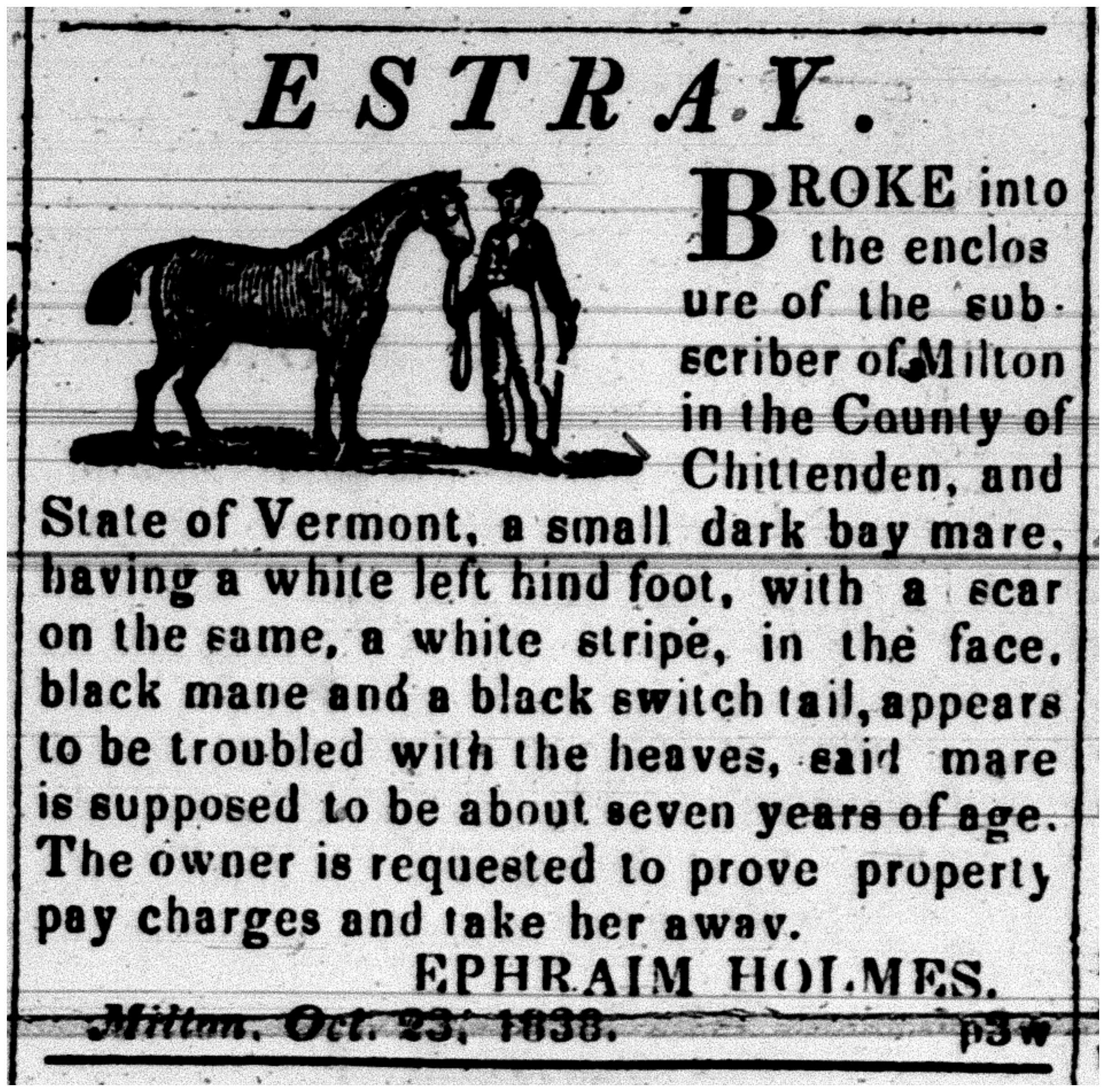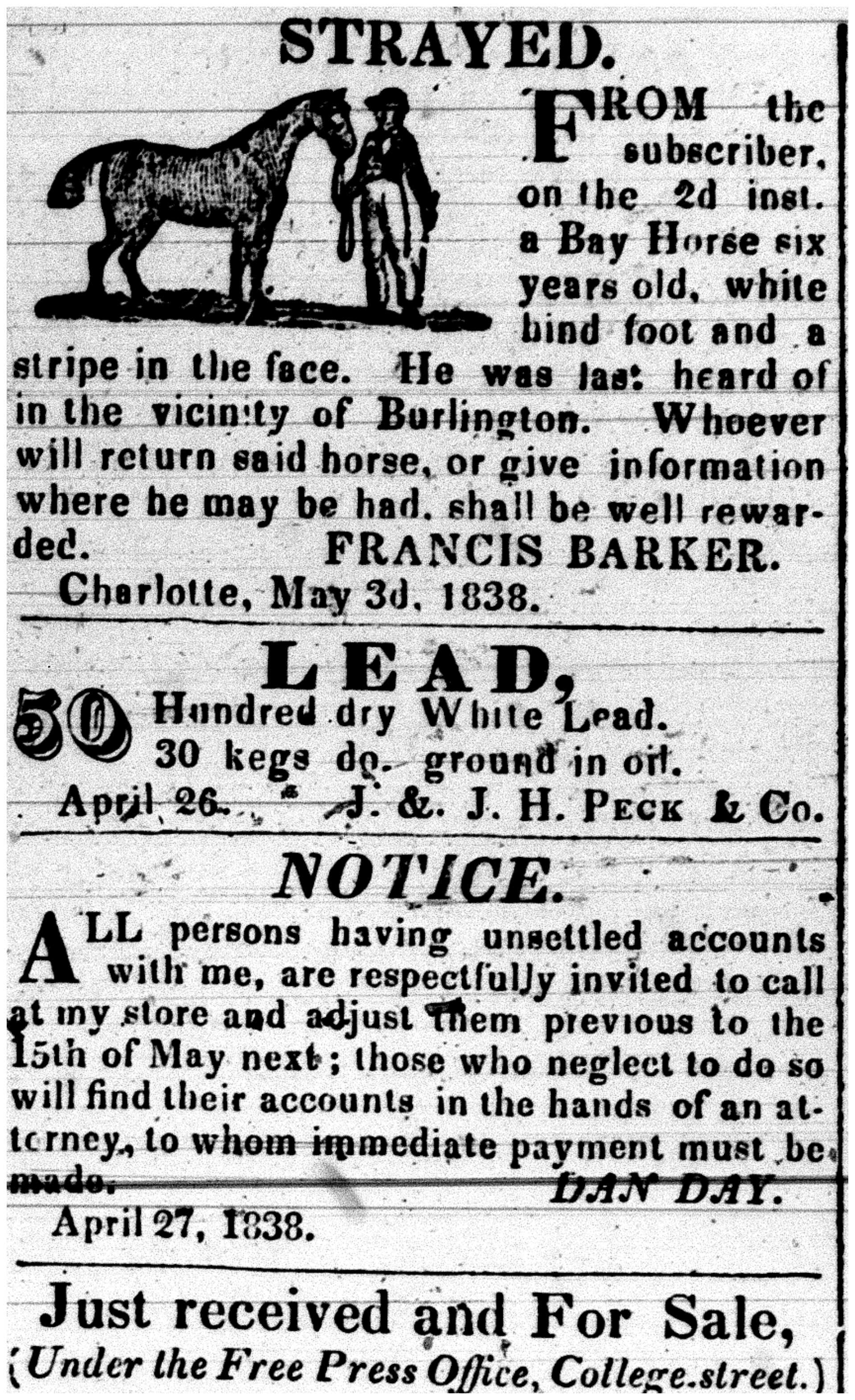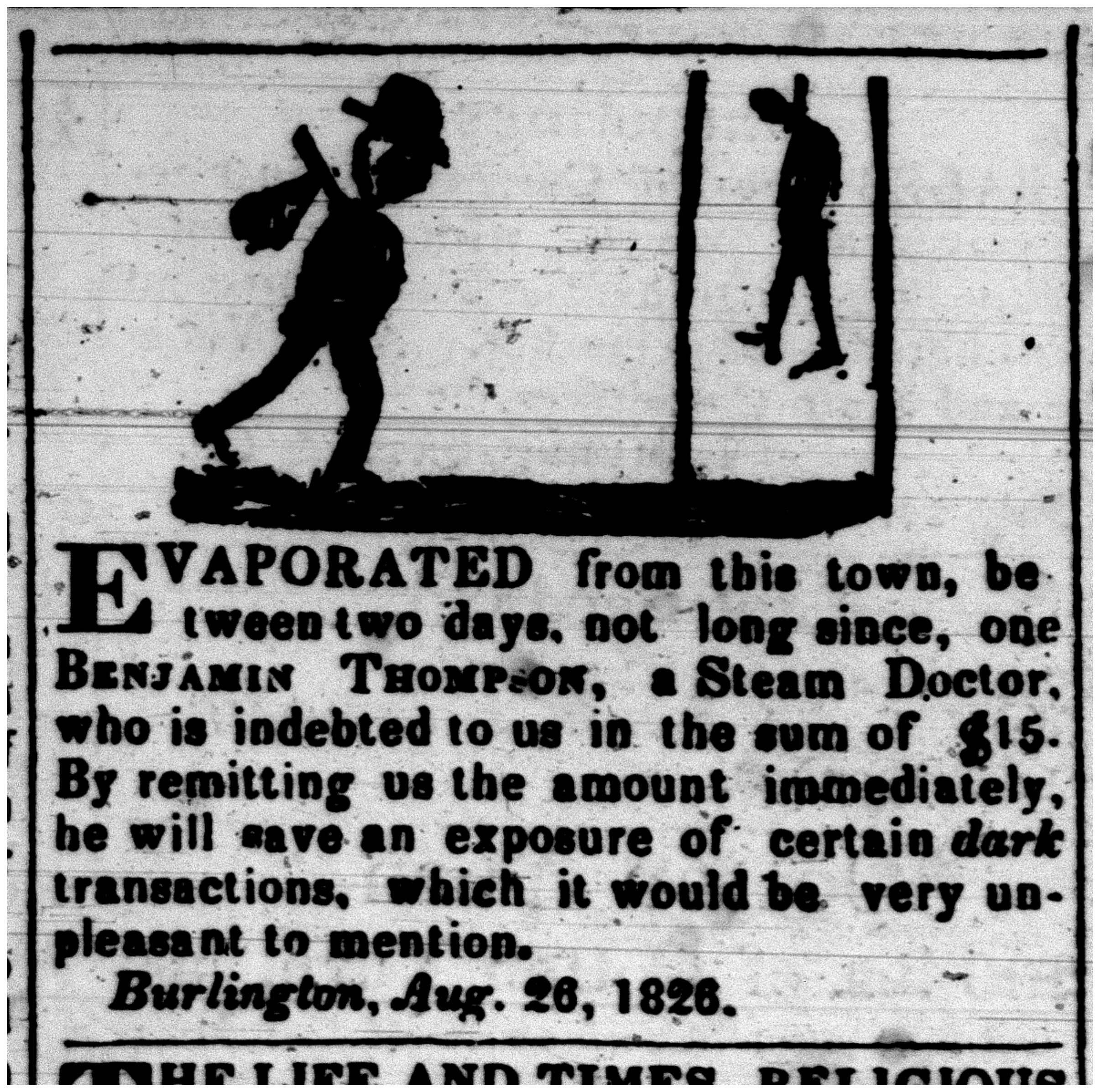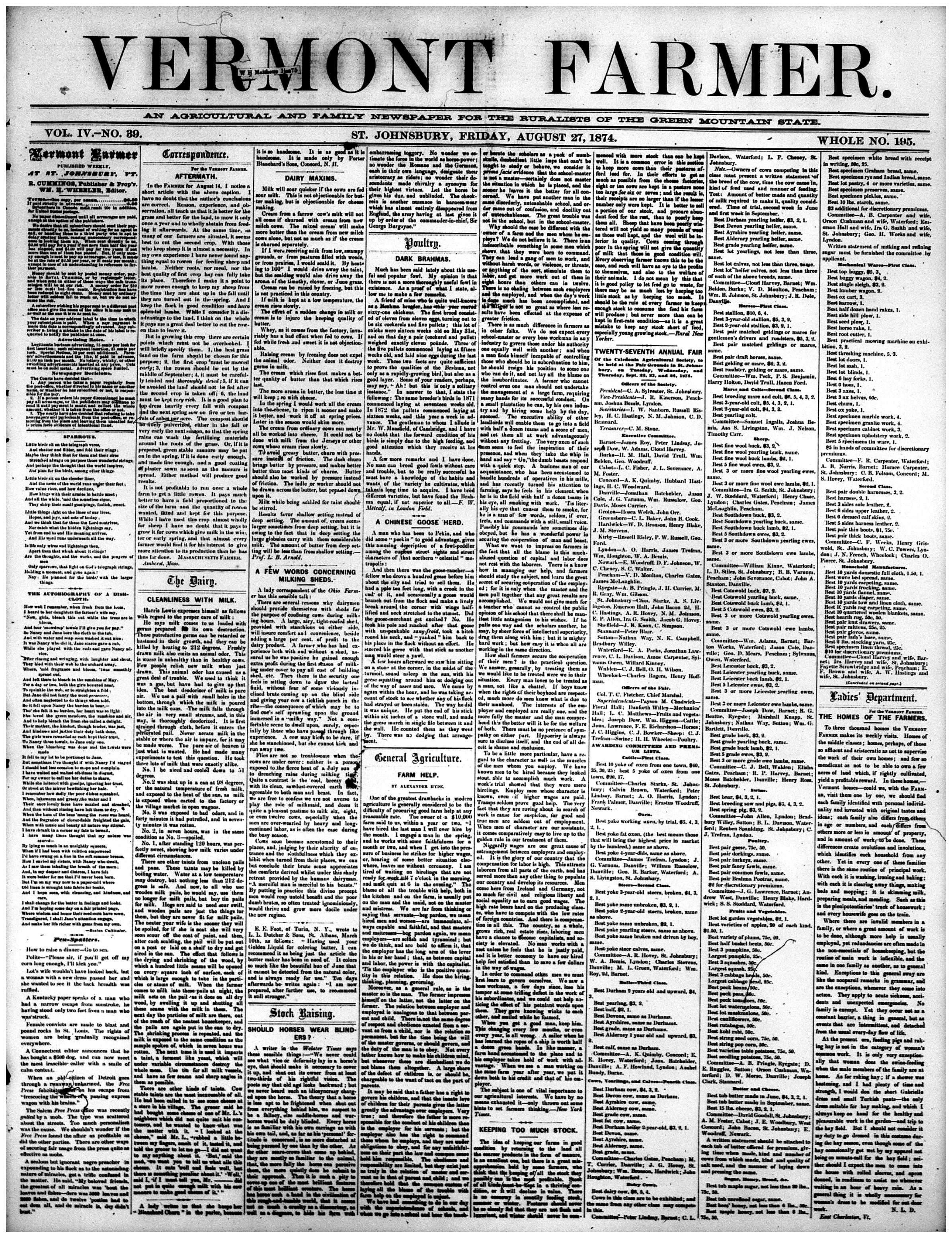All posts by VTDNP
Deb Thomas giving a talk on the NDNP at UVM
Thursday, April 21, 5:00 pm., Special Collections Reading Room, Bailey/Howe Library
Deborah Thomas, Program Coordinator for the National Digital Newspaper Program (NDNP) at the Library of Congress, will talk about the effort to digitize historically significant newspapers from all over the United States and make them freely available through Chronicling America: Historic American Newspapers, a web site hosted by the Library of Congress.
In 2010 the University of Vermont of Vermont Libraries was awarded an NDNP grant to support the Vermont Digital Newspaper Project. The UVM Libraries and the Vermont Department of Libraries, the Ilsley Public Library of Middlebury, and the Vermont Historical Society will digitize up to 100,000 pages of Vermont newspapers published between 1836 and 1922. The digitized newspapers will be available to the public via Chronicling America.
Staff from the Vermont Digital Newspaper Project, including Project Director Birdie MacLennan and Project Librarian Tom McMurdo, will talk about the Vermont project following Deborah Thomas’s presentation.
The presentation is free and open to the public. For more information, call 802-656-1493 or email uvmsc@uvm.edu.
Highlights from 1830s and 1840s Burlington Free Press
One of the first digitization projects we are working on here at the VTDNP is the Burlington Free Press from 1836-1848. We are also working on the Rutland Herald from 1836-1854, and the Vermont Farmer from St. Johnsbury in the 1870s. Today, I want to share some quick scans from the Burlington Free Press. (These are scans from the film that has been in use for some years, and are not as high quality as the final product will be.)
These great titles are loaded with wonderful history of Vermont from the early to mid 19th century. As I have been working with these titles, I find that my attention is often drawn to the advertisements. The advertisements are dominated by patent medicines for any number of conditions we scarcely think of today, like worms, scrofula, the vague category of “blood disorders,” and all of the medicines for weak and ill children. It is humbling to see these advertisements. It is a reminder of how hard life was for our forebears, armed only with these often useless defenses against pain, suffering and death.
Mixed in with these advertisements are notices that exemplify the charm and simplicity of those days. These two, both from 1838, depict a common problem people in the Burlington area had–animals straying off or straying on to their land (click them for a larger version):

 Other ads give a much different view of life in the era. If you think bankruptcy today is bad, take a look at this ad from September 2, 1838:
Other ads give a much different view of life in the era. If you think bankruptcy today is bad, take a look at this ad from September 2, 1838:
I certainly wouldn’t want to be Benjamin Thompson (if that was his real name) if they ever caught up with him.
This remarkable ad from May 6, 1836 shows a traveling “Zoological Exhibition” that features a “Unicorn” (rhinoceros):
There are so many interesting articles and advertisements, I can scarcely begin to share them here. One article that I encountered from August 30, 1838 that may be of particular interest is this piece where the editor of the Free Press complains at length about the cost of the new Vermont Statehouse in Montpelier:
(Click the image to see a larger, eye-readable version.)
This title for 1836-1848 will be one of the first available that we digitize, along with the Rutland Herald for 1836-1854. I hope to bring you similar highlights from the Rutland Herald in the near future. These titles, and all of the titles we are working with, open a fascinating window into an era that is populated by wandering horses, incredible animals, and people very much like us making the best of their lives. We are looking forward to bringing you all of these titles fully digitized and searchable in collections online.
– Tom McMurdo, VTDNP Project Librarian
Just how much is 100,000 pages?
When I look at a book like War and Peace, I think something like: “Now, that’s a big book.” I imagine most people would agree, since Tolstoy’s epic novel comes in at over 1,200 pages. When most of us look at a book of this size, there is a kind of math that occurs in our minds that is something like: (length of book) X (time to read each page) / (personal interest X time for reading in our life). We might read a book that is fairly short even if it is not of great interest to us, but reading 1,000 pages isn’t going to happen unless the reader is motivated to read that specific book.
The math for newspapers is something different. Most of us read news stories every day. This parsing out of a few pages here and there–with more on Sundays–means that newspapers are publishing the equivalent of War and Peace in a fairly short time. A nice big city daily might publish 400 or 500 pages a week. This has certainly waned in recent years as newspapers have gotten smaller, but in the course of a month, we are talking about a rather large number of pages–2,000 or more, in some cases. Few of us sit down to read a 2,000 page book every month, but our daily newspapers are giving us just that.
The grant for the Vermont Digital Newspaper Project specifies that we should digitize 100,000 pages of Vermont newspapers from 1836-1922. 100,000 sounds like a lot (and it is!), but in the context of the daily newspaper, it suddenly seems a lot smaller. Most Vermont newspapers during the grant period of 1836-1922 were weeklies, often just 4 pages per issue until the 1870s or 1880s, but beginning with the (Burlington) Daily Free Press in 1848, the daily newspaper was on the scene in Vermont. Newspapers in other Vermont towns and cities followed, like the Rutland Daily Herald in 1861. Soon, the Bennington Banner, Burlington Daily News, Rutland Daily Globe, Barre Daily Times, Montpelier Daily Journal, the Brattleboro Daily Reformer, and other newspapers were published daily all over the state.
Most of these 19th century dailies were just four pages when they started, but they grew as the century progressed. Many dailies in Vermont were 12, 14, or 16 pages by the turn of the century. Those kind of page counts really start to add up! In fact, the VTDNP has already identified microfilm negatives for over 700,000 pages of long runs of newspapers in the state for 1836-1922. This tally grows greatly if we include short runs of papers. We are investigating two long runs of dailies that would easily push the total to over one million pages. And that’s just for newspapers published in Vermont between 1836-1922! Throw in all the 20th and 21st century newspapers, and the total number of pages becomes staggering.
Wow–just think of all that information! Right now it is at the library, on analog media (microfilm), stowed away and patiently waiting for its time to be digitized. 100,000 pages is just a small fraction of these newspapers, but that is exactly why this project so important. These 100,000 text-searchable pages will provide an unparalleled treasure trove of day-to-day Vermont history that can be accessed right from your computer, in high resolution. But, it is in the context of all those other pages that the Project’s value is multiplied: the establishment of clear standards and practices for digitizing newspapers means future digitization projects will create digitized pages that are readable, usable, and preserved for research now and for future generations.
– Tom McMurdo, VTDNP Project Librarian
Our first title
Our first title selected for digitization under our NDNP grant doubles as our sample reel. We sent this reel to our potential project partner vendors as part of the RFP process. It is referred to as a “sample reel” because each of the potential vendors will create a batch of images from the microfilm as part of the evaluation for the RFP. Because it will be used for this dual purpose, the title we chose had to fulfill certain important criteria: it would preferably be a short run that fits all on one reel, the location of the master negative had to be known, and–most importantly–the title has to be historically important and interesting.
After some deliberation and searching, we found a title that meets all of these requirements:
The Vermont Farmer (St. Johnsbury, VT).
The Vermont Farmer is noteworthy in several ways. Prudence Doherty, University of Vermont Special Collections Librarian and VTDNP Project Management Team member, researched the background of The Vermont Farmer. Prudence located this wonderful article detailing the background of the title and its remarkable editor:
“Dr. Thomas H. Hoskins was born in Gardiner, Maine, on May 14, 1828, son of Henry Box Hoskins, a paper manufacturer there for forty years and twice Mayor. Following a very interesting career as a physician and surgeon in and around Boston, Massachusetts, after graduating from Louisville, Kentucky, Medical School in 1866, Dr. Hoskins received a severe spinal injury from a fall on the ice, which incapacitated him for his professional work. Soon after, at the invitation of his friends Henry Keyes and Carlos Pierce, he came to Newport to regain his health. While here, the idea occurred to him that the lake region would be a good place for fruit raising. While practicing at the Boston Dispensary he had also worked as an editorial writer on the Boston Courier. He was the author of “A Treatise on the Adulteration of Food.” Dr. Hoskins became the Agricultural Editor of the Newport Express and an expert on agriculture and horticulture.
Dr. Hoskins established a nursery at West Derby about 1868 in the Hoskins Avenue area and began experimenting with many varieties. He bought a farm in Newport Center where he developed a twelve-acre orchard and in 1890 bought 135 acres in Derby to develop one of the best orchards in New England with nearly one hundred varieties of apple trees. He attempted constantly to find the best apples to withstand the cold climate and apple trees and fruit from his nursery were readily sold. He introduced the Yellow Transparent, Scott’s Winter, Tetoffsky, the Dutchess, the Wealthy, and Newport apples. He propagated the Vermont Wonder Pea and Snowflake Potato.
In 1870 Dr. Hoskins started printing the Vermont Farmer at Newport and after two years moved it to St. Johnsbury where for four years he served as Editor with Royal Cummings as Publisher. The newspaper reached a circulation of four thousand. For two years the doctor was a member of the State board of Agriculture and contributed to the Vermont Horticultural Society records now at the University of Vermont. For twenty years he was Agricultural Editor of the Watchman and a contributor to the Rurual New Yorker, Garden and Forest, American Gardening, and other journals. His work in the nursery required money, patience, and experience over many years but he is now best remembered for the McIntosh Red apple. In 1868 Dr. Hoskins bought from the John McIntosh family nursery in Dundela, Ontario, a McIntosh apple tree which he planted in his orchard in Newport Center. This was the first McIntosh sapling planted in the United States. It is !
still living and bearing fine fruit on the Gilbert C. Whipple farm where he planted it. His work in horticulture has been continued by the University of Vermont Extension Service which has recently developed a new and improved strain of apples, called The Imperial.
Dr. Hoskins, at the age of eighteen, married Mary Jane Harrington of Boston, and after her death married Caroline A. Strong, also of Boston, who died a year later in childbirth. His third wife, Malona A. Pino of Georgia, Vermont, became the mother of his six children. In 1896 only one was still living, Mabel C., the wife of the Reverend J.B. Spires who resigned his pastorate to assist Dr. Hoskins in his fruit farming and nursery.
The Reverend Spires was born in 1862 at Reems Station, Dinwiddie County, Virginia, where his father was a Methodist clergyman and practicing physician. He graduated from Boston Theological Seminary in June, 1890, and soon married Mabel Hoskins. The Reverend Spires and Dr. Hoskins made a specialty of rhubarb, asparagus, and fruits, but their main business, beside selling many trees, was the sale of apples and small fruits. Their business increased steadily and they maintained their excellent reputation as orchardists. Dr. Hoskins possessed a vigorous and original personality.”
[Citation forthcoming, p. 155-156, from a Vermont state history book]
Besides the notable change of career from surgeon to horticulturalist after his spinal injury, it is fascinating that Dr. Hoskins introduced the McIntosh Red apple to the United States! The Vermont Farmer should provide researchers with an informative window into agricultural thought and practice in Northeast Vermont in the 1870s.
Some notes on the article: Newport and Derby are located within five miles of the Quebec, Canada border in Northeastern Vermont. The “lake region” referred to in the article is the area around Lake Memphremagog, which straddles the U.S.-Canada border. St. Johnsbury–where the publication of the Vermont Farmer moved in 1872–is about 40 miles southeast of Newport near the New Hampshire border.
– Tom McMurdo, VTDNP Project Librarian




